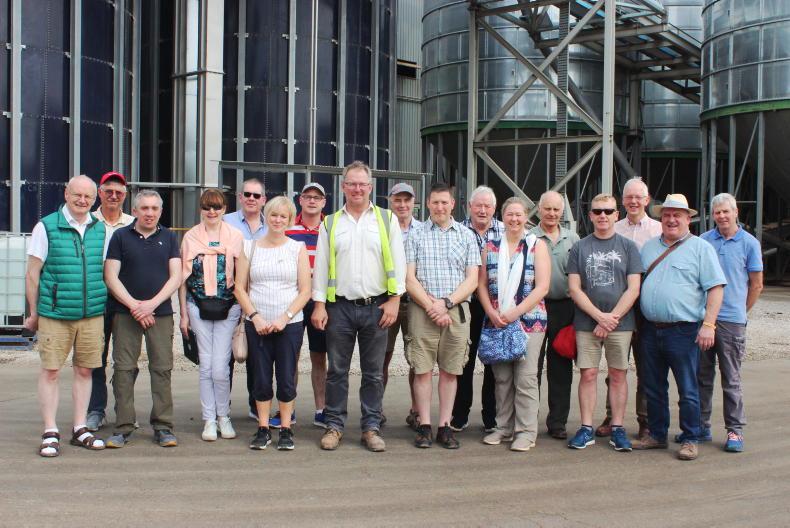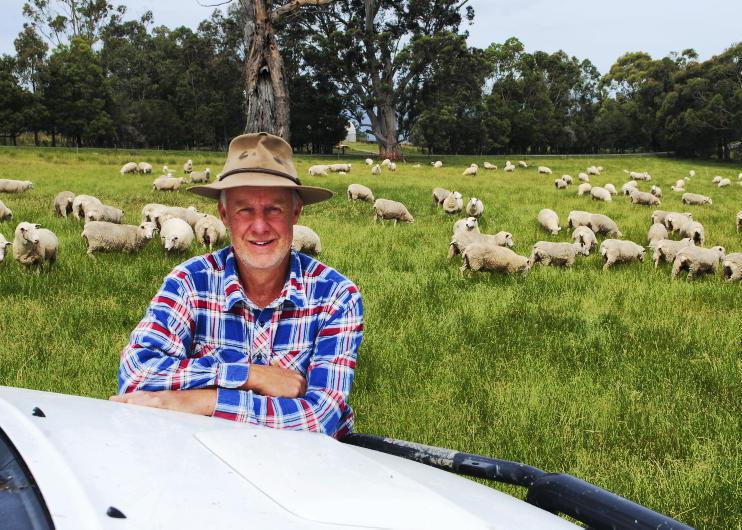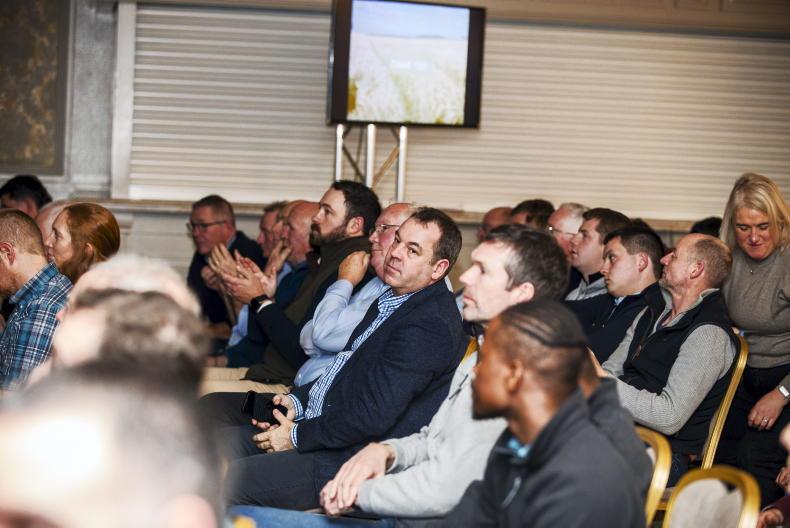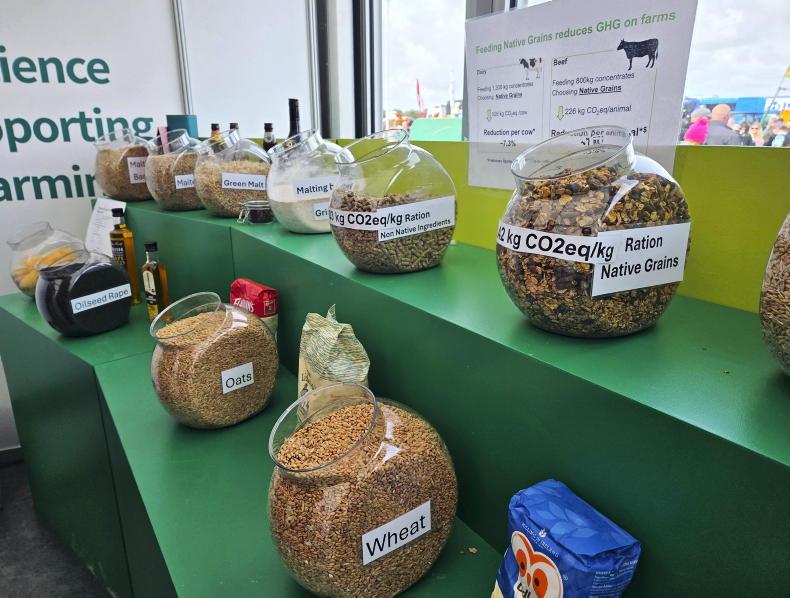On 10 January 2020, a small group travelling on an Irish Tillage and Land Use Society study tour arrived in Perth to begin a three-week tour of agricultural visits in three states in Australia. We arrived at a time when Australia was making international news every day because of the rampant wildfires caused by drought and extreme temperatures.
This meant a risk of considerable disruption to our travel and accommodation plans but we never missed a beat or a visit. Indeed, we saw virtually nothing of the fires other than where they had been. This is a brief summary of the tour and you can follow the links to see more details of each visit.
1 We began our three weeks of visits in our hotel in Perth when we met with Andrew Crane, the former chief executive of the giant CBH grain handling facility. Andrew gave us a quick understanding of farming in Western Australia and briefed us about what we were likely to see in our travels. Read more about this discussion here.
Our first road trip took us east from Perth to Hyden. The first two days of travel left some indelible memories. The space, the emptiness, straight roads and views that left us numb to the concept of scale. The rolling countryside was the only thing that hindered our view to infinity.
We had no phone signal for about two days of travel. Some of the fields, or paddocks as they call them, were three to five kilometres in length. Kangaroo carcases and skeletons lay by the roadsides. The paved or tarmac roads had a graded soil edge that ran to an open drain but inside that there remained a section of the former bush that varied in width. This had to be left in situ when the land was reclaimed.
2 This was our 16th study tour, but we had never seen anything like this before. During our early days of travel, we could see structures on the rolling landscape which seemed to be designed to divert and collect rainwater. We quickly learned that groundwater is not drinkable because of high salt levels and so all life depends on the successful capture and storage of rainwater. Large holes or pits (known as dams) were carved from the ground as the primary collection points. Read more about this here.
3 Following an overnight in Hyden, we travelled southeast initially through Lake King and Ravensthorpe to join the main highway from Albany to Esperance and then headed north to visit Sam Defrenne. Sam farms over 8,000ha of cereals using a controlled traffic system and his situation was unusual in that he had no livestock on the farm. Read more about Sam’s business at www. ifj.ie/ITLUS3
4 Following an overnight in Esperance, we travelled further east to meet with Andrew Fowler and his family. This was a fascinating visit which provided great memories as well as a great insight into the Folwers’ 30,000ha farming operation. This farm is on the eastern edge of the last big reclamation project and the paved road ended at the farm entrance. The fact that Andrew’s wife Marie was a native of Armoy in Co Antrim added to our experience. There were a few focal as gaeilge around the house and the children were Bronagh and Séan. You can read more about this farm here.
5 The following day we headed west to meet with Reece Curwen near Talalarup south of the Stirling mountains and about 100km northeast of Albany. This was a very contrasting visit as the land was older and had suffered significant degradation over time. Reece has an intensive sheep operation which is important in terms of maintaining and improving the land. He was working to improve the sustainability of his land and its potential productivity. Read more about it here.
Our return trip to Perth took us up through Margaret River to view some more intensive farming in a higher-rainfall area which is particularly renowned for its grapes and wines. There were far more people now too and the higher the rainfall the smaller the farms.
When we got back to Perth airport our five days in WA had seen us cover almost 2,600km before we departed for Sydney and New South Wales.
6 We began the second leg of the tour in Sydney on 17 January and headed to the southwest edge of the city to meet with a persimmon grower, Brett Guthrey. For us persimmons were a new crop. He told us about the crop but also about the need to continuously reinvent the business to try to retain income potential. Read more about this here.
7 From there we headed back up north and then west to cross the Blue Mountains on the A32 towards Katoomba. That afternoon we headed to Manildra to visit MSM Milling, a company involved in crushing canola. There we met with Peter Moes who told us about their oil crushing business and the use of woodchip to provide heat. Read more about this here.
8 On 18 January we headed up to Molong to visit with Rob Peffer and Canobolas Eggs. There we learned about the many challenges of being an egg producer and saw first-hand most elements of the business, including a separate unit built to produce free-range eggs. You can read more about this here.
That afternoon we visited Cumulus vineyards to the northeast of Molong. This is the largest single-estate vineyard in New South Wales with 508ha of vines at either side of 600m altitude set in the rolling hills of Boomey. There, Marty Grandson explained the many challenges of producing grapes for wine and the challenges of water and disease management in an unpredictable climate.
9 The next day we visited a farm that is somewhat known to Irish Farmers Journal readers because one of its partners, Bruce Watson, is an occasional contributor. Bruce could not be present during our visit so we met with his partner, Mark Swift. He showed us around the farm and other local attractions like the Parkes radio telescope used for the first moon landing.
Read more about that here.
As well as being shown around the farm, we were treated to tremendous hospitality by Bruce’s parents and Mark’s parents-in-law, Jim and Janelle Watson for a very memorable evening.
10 On 20 January we headed southeast from Parkes to visit the Moxey Farms dairy unit located along the Lachlan River near Gooloogong. This was a very impressive business, with cows housed all year round and the feed/forage grown locally with the help of irrigation. The farm had an anaerobic digester located underground in the centre of the farmyard complex. Read more at ifj.ie/ITLUS10
As we got closer to Griffith, we came into the Riverina region and the Murrumbidgee Irrigation Area, which is about 160,000ha and critical to the diversity of agriculture in that region. The region normally grows a substantial area of rice but production was down 90% in 2020 because of the scarcity of water.
11 Then we travelled southwest to Griffith and stopped off in Bilbull to visit Mat Ryan at the Murray Cod fish farm. It seemed strange to find a fish farm in the middle of a dry state, but irrigation water was available. It was fascinating to see how the system worked, the need to oxygenate the water and the need to protect the fish from predators etc. Read more here.
12 The next day we visited another name that is familiar to IFJ readers, Scott Vaessen. He too is an occasional contributor who produces grain, lamb and wool on about 9,000 acres. Scott is caring for his land and spreads organic manures to improve it. He had recently sold land to a neighbouring poultry business which is hoping to rear 4.4m broilers annually. Read more here.
13 That afternoon we visited almond and macadamia plantations and learned about the Murrumbidgee Irrigation system (read more at www.ifj.ie/ITLUS13) and finished with a gherkin grower and processor (read more here). A gherkin is an immature cucumber which is harvested and processed. Ben Parle gave us a rundown on how they supply McDonald’s Australian requirement.
14 On 22 January we headed back to Sydney and stopped off at the Yanco Managed Environment Facility. This research facility was examining various aspects of rice and cotton production in dry and irrigated systems. David Troldahl took us on a very interesting tour of the facility. Read more here.
15 That evening we visited Robert Hart at Hart Seeds near Junee. The scenery changed dramatically as we moved from irrigation back into dryland farming. Robert gave us a rundown on the seed business and the ongoing impact of the drought. See more here.
Queensland was much greener
16 By Friday 24 January we were over 80km west of Brisbane in Queensland meeting with Lachlan Hauser. The countryside along the way was greener with more pasture – a sign of higher rainfall. We visited this farm with Fiona Neville of Syngenta. Lachlan has concentrated heavily on improved efficiency across his crop production and handling, with an even greater emphasis on care for the soil. Read more here.
17 The next day Tim Fraser of Syngenta took us west of Toowoomba to meet with Liam, who looked after Ashley Keldar’s cotton. Liam explained that water is the main driver of crop yield, so irrigation was critical. Read more here.
18 In the afternoon we visited Greg Hartwick, a sorghum grower near Chinchilla and about 160km northwest of Toowoomba. This was a common crop in the region, with almost 66% of the cropland area producing feed for pigs.
Sorghum grain is also known as milo. Read more here.
On 26 and 27 January we travelled nearly 700km on inland roads from Toowoomba to Bundaberg and even further north. This journey brought us through very varied countryside which ranged from crops to livestock and mountain.
19 On 28 January we visited some Bundaberg Sugar crops with Simon Doyle. He took us to some cane plantations and told us about some other crops now being grown in the area. Read more here.
20 Later that day we visited Keith Martens who is a big watermelon producer to learn a bit about that crop and then on to Mario and Gordon Oakes who grow pineapples (more on these here).
21 Later we visited the Russo brothers near Childers to see and learn about groundnut or peanut production. Read more about this here.
22 The next day 29 January was our last day of farm visits. We met up with Paul Hinder at the Yandina branch of Nutrien Ag Solutions who took us to meet with Jade Weston, a member of a family-owned ginger production business. This was a very technical and profitable crop option. Read more here.
By 31 January our tour had come to an end and the journey home had begun. We had seen a lot and learned about the importance of rain and backpackers for Australian agriculture. We had put in about 7,000km of road travel and possibly saw more of this huge country than many Australians ever did.
Having been fearful of the risks and uncertainties associated with bush and forest fires at the start, we managed to get all the fires out as the rain followed us around. By the time we set out for home we had become conscious of a new concern – COVID-19.
The summary and story links shown here provide readers with an opportunity to dip in and out of the tour to get a feel for the vastness and variety of this fascinating country.
On 10 January 2020, a small group travelling on an Irish Tillage and Land Use Society study tour arrived in Perth to begin a three-week tour of agricultural visits in three states in Australia. We arrived at a time when Australia was making international news every day because of the rampant wildfires caused by drought and extreme temperatures.
This meant a risk of considerable disruption to our travel and accommodation plans but we never missed a beat or a visit. Indeed, we saw virtually nothing of the fires other than where they had been. This is a brief summary of the tour and you can follow the links to see more details of each visit.
1 We began our three weeks of visits in our hotel in Perth when we met with Andrew Crane, the former chief executive of the giant CBH grain handling facility. Andrew gave us a quick understanding of farming in Western Australia and briefed us about what we were likely to see in our travels. Read more about this discussion here.
Our first road trip took us east from Perth to Hyden. The first two days of travel left some indelible memories. The space, the emptiness, straight roads and views that left us numb to the concept of scale. The rolling countryside was the only thing that hindered our view to infinity.
We had no phone signal for about two days of travel. Some of the fields, or paddocks as they call them, were three to five kilometres in length. Kangaroo carcases and skeletons lay by the roadsides. The paved or tarmac roads had a graded soil edge that ran to an open drain but inside that there remained a section of the former bush that varied in width. This had to be left in situ when the land was reclaimed.
2 This was our 16th study tour, but we had never seen anything like this before. During our early days of travel, we could see structures on the rolling landscape which seemed to be designed to divert and collect rainwater. We quickly learned that groundwater is not drinkable because of high salt levels and so all life depends on the successful capture and storage of rainwater. Large holes or pits (known as dams) were carved from the ground as the primary collection points. Read more about this here.
3 Following an overnight in Hyden, we travelled southeast initially through Lake King and Ravensthorpe to join the main highway from Albany to Esperance and then headed north to visit Sam Defrenne. Sam farms over 8,000ha of cereals using a controlled traffic system and his situation was unusual in that he had no livestock on the farm. Read more about Sam’s business at www. ifj.ie/ITLUS3
4 Following an overnight in Esperance, we travelled further east to meet with Andrew Fowler and his family. This was a fascinating visit which provided great memories as well as a great insight into the Folwers’ 30,000ha farming operation. This farm is on the eastern edge of the last big reclamation project and the paved road ended at the farm entrance. The fact that Andrew’s wife Marie was a native of Armoy in Co Antrim added to our experience. There were a few focal as gaeilge around the house and the children were Bronagh and Séan. You can read more about this farm here.
5 The following day we headed west to meet with Reece Curwen near Talalarup south of the Stirling mountains and about 100km northeast of Albany. This was a very contrasting visit as the land was older and had suffered significant degradation over time. Reece has an intensive sheep operation which is important in terms of maintaining and improving the land. He was working to improve the sustainability of his land and its potential productivity. Read more about it here.
Our return trip to Perth took us up through Margaret River to view some more intensive farming in a higher-rainfall area which is particularly renowned for its grapes and wines. There were far more people now too and the higher the rainfall the smaller the farms.
When we got back to Perth airport our five days in WA had seen us cover almost 2,600km before we departed for Sydney and New South Wales.
6 We began the second leg of the tour in Sydney on 17 January and headed to the southwest edge of the city to meet with a persimmon grower, Brett Guthrey. For us persimmons were a new crop. He told us about the crop but also about the need to continuously reinvent the business to try to retain income potential. Read more about this here.
7 From there we headed back up north and then west to cross the Blue Mountains on the A32 towards Katoomba. That afternoon we headed to Manildra to visit MSM Milling, a company involved in crushing canola. There we met with Peter Moes who told us about their oil crushing business and the use of woodchip to provide heat. Read more about this here.
8 On 18 January we headed up to Molong to visit with Rob Peffer and Canobolas Eggs. There we learned about the many challenges of being an egg producer and saw first-hand most elements of the business, including a separate unit built to produce free-range eggs. You can read more about this here.
That afternoon we visited Cumulus vineyards to the northeast of Molong. This is the largest single-estate vineyard in New South Wales with 508ha of vines at either side of 600m altitude set in the rolling hills of Boomey. There, Marty Grandson explained the many challenges of producing grapes for wine and the challenges of water and disease management in an unpredictable climate.
9 The next day we visited a farm that is somewhat known to Irish Farmers Journal readers because one of its partners, Bruce Watson, is an occasional contributor. Bruce could not be present during our visit so we met with his partner, Mark Swift. He showed us around the farm and other local attractions like the Parkes radio telescope used for the first moon landing.
Read more about that here.
As well as being shown around the farm, we were treated to tremendous hospitality by Bruce’s parents and Mark’s parents-in-law, Jim and Janelle Watson for a very memorable evening.
10 On 20 January we headed southeast from Parkes to visit the Moxey Farms dairy unit located along the Lachlan River near Gooloogong. This was a very impressive business, with cows housed all year round and the feed/forage grown locally with the help of irrigation. The farm had an anaerobic digester located underground in the centre of the farmyard complex. Read more at ifj.ie/ITLUS10
As we got closer to Griffith, we came into the Riverina region and the Murrumbidgee Irrigation Area, which is about 160,000ha and critical to the diversity of agriculture in that region. The region normally grows a substantial area of rice but production was down 90% in 2020 because of the scarcity of water.
11 Then we travelled southwest to Griffith and stopped off in Bilbull to visit Mat Ryan at the Murray Cod fish farm. It seemed strange to find a fish farm in the middle of a dry state, but irrigation water was available. It was fascinating to see how the system worked, the need to oxygenate the water and the need to protect the fish from predators etc. Read more here.
12 The next day we visited another name that is familiar to IFJ readers, Scott Vaessen. He too is an occasional contributor who produces grain, lamb and wool on about 9,000 acres. Scott is caring for his land and spreads organic manures to improve it. He had recently sold land to a neighbouring poultry business which is hoping to rear 4.4m broilers annually. Read more here.
13 That afternoon we visited almond and macadamia plantations and learned about the Murrumbidgee Irrigation system (read more at www.ifj.ie/ITLUS13) and finished with a gherkin grower and processor (read more here). A gherkin is an immature cucumber which is harvested and processed. Ben Parle gave us a rundown on how they supply McDonald’s Australian requirement.
14 On 22 January we headed back to Sydney and stopped off at the Yanco Managed Environment Facility. This research facility was examining various aspects of rice and cotton production in dry and irrigated systems. David Troldahl took us on a very interesting tour of the facility. Read more here.
15 That evening we visited Robert Hart at Hart Seeds near Junee. The scenery changed dramatically as we moved from irrigation back into dryland farming. Robert gave us a rundown on the seed business and the ongoing impact of the drought. See more here.
Queensland was much greener
16 By Friday 24 January we were over 80km west of Brisbane in Queensland meeting with Lachlan Hauser. The countryside along the way was greener with more pasture – a sign of higher rainfall. We visited this farm with Fiona Neville of Syngenta. Lachlan has concentrated heavily on improved efficiency across his crop production and handling, with an even greater emphasis on care for the soil. Read more here.
17 The next day Tim Fraser of Syngenta took us west of Toowoomba to meet with Liam, who looked after Ashley Keldar’s cotton. Liam explained that water is the main driver of crop yield, so irrigation was critical. Read more here.
18 In the afternoon we visited Greg Hartwick, a sorghum grower near Chinchilla and about 160km northwest of Toowoomba. This was a common crop in the region, with almost 66% of the cropland area producing feed for pigs.
Sorghum grain is also known as milo. Read more here.
On 26 and 27 January we travelled nearly 700km on inland roads from Toowoomba to Bundaberg and even further north. This journey brought us through very varied countryside which ranged from crops to livestock and mountain.
19 On 28 January we visited some Bundaberg Sugar crops with Simon Doyle. He took us to some cane plantations and told us about some other crops now being grown in the area. Read more here.
20 Later that day we visited Keith Martens who is a big watermelon producer to learn a bit about that crop and then on to Mario and Gordon Oakes who grow pineapples (more on these here).
21 Later we visited the Russo brothers near Childers to see and learn about groundnut or peanut production. Read more about this here.
22 The next day 29 January was our last day of farm visits. We met up with Paul Hinder at the Yandina branch of Nutrien Ag Solutions who took us to meet with Jade Weston, a member of a family-owned ginger production business. This was a very technical and profitable crop option. Read more here.
By 31 January our tour had come to an end and the journey home had begun. We had seen a lot and learned about the importance of rain and backpackers for Australian agriculture. We had put in about 7,000km of road travel and possibly saw more of this huge country than many Australians ever did.
Having been fearful of the risks and uncertainties associated with bush and forest fires at the start, we managed to get all the fires out as the rain followed us around. By the time we set out for home we had become conscious of a new concern – COVID-19.
The summary and story links shown here provide readers with an opportunity to dip in and out of the tour to get a feel for the vastness and variety of this fascinating country.










SHARING OPTIONS